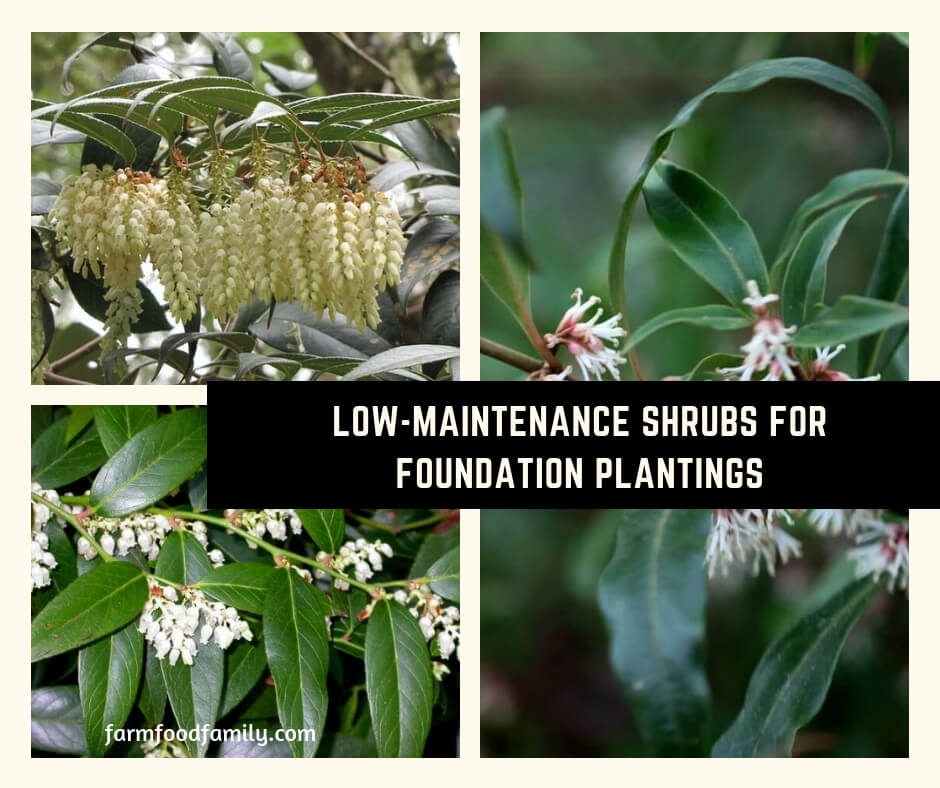Low-maintenance small evergreen shrubs are first-rate selections for DIY landscape foundation plantings. They enrich the looks of shady front yard landscapes.
Plant breeders continue to introduce shrubs that save maintenance time, effort, and money. These introductions are smaller than their normal-sized relatives and often labeled as dwarfs.
They are relatively disease and pest resistant. Both needle-leaf and broad-leaf evergreen varieties offer year-round color interest.
The 21st century tradition of foundation plantings persists in many regions. Problems result when small trees and shrubs overwhelm foundation area spaces.
Habitually, shearing plants into contorted shapes is used to maintain optimal sizes. This practice leads to bizarre looking and unhealthy plants.
Plant Suggestions
Below are suggestions for up-to-the-minute low-maintenance dwarf evergreen landscape plants for foundation landscape plantings. These plants are relatively slow growing and require little maintenance over the years.
Shearing distorts their natural positive features and requires unnecessary work. Most do not require pruning except for snipping off wayward and winterkilled branches.
Suggestions are for plantings two to three layers deep:
- small ground-huggers if desired,
- medium fillers, and
- dynamic background plants.
Ultimate heights of mature plants are lower than most front windows. Because these plants appear small when bought in containers, it is important to space according to mature spread. This avoids overcrowding of mature plants.
Groundcovers for Front of Border – Layer #1
Paxistima canbyi – Canby Paxistima – North American Native (Photo #1)

- Size, Habit and Form: 12″ tall, spreading to 3′ or 4′ or more, low, with multiple stems that are fine and flexible;
- Features: summer foliage is lustrous dark green color with leaves crowded on stems; autumn foliage bronzes a little; flowers in early May, not particularly showy, are small greenish or reddish, held in small clusters;
- Culture: prefers moist but well-drained soil, likes high soil organic matter content, tolerates high pH soils (alkaline); full sun is best, but does well in partial shade; avoid high fertilization.
Front of Border – Layer #1
Taxus baccata ‘Repandens’ – Spreading English Yew

- Size, Habit and Form – will reach 2 to 4′ high by 10′ wide in time but can easily be kept smaller; set plants 3′ on center and prune lightly to maintain low growing, softly arching branches; form develops best when English yew has room to spread and is left unpruned;
- Features – tolerates temperatures as low as -20 degrees F/-28 degrees C; ‘Repandens’ is a female clone, so it bears fruit; bark, foliage and fruit can be toxic to children and grazing animals; one of the few conifers that thrives in shade. Generally pest and disease free, but can develop scale (and resulting sooty mold) and black vine weevil;
- Culture – prefers well-drained soil and is drought tolerant once established.
Daphne odora ‘Aureomarginata’ – Variegated Winter Daphne

- Size, Habit and Form – grows to 4′ high and 5 or 6′ across with time; may grow fast in right conditions, however, it often reaches only about two-thirds optimal size;
- Qualities – small waxy-looking fragrant flowers that emerge from purple buds in March and April; long, narrow leaves edged in creamy gold;
- Culture – likes fertile, humus-rich, well-drained soil in part shade, foliage burns in hot afternoon sun, drought tolerant once established; mulch in March, add a handful of all-purpose organic fertilizer to keep foliage a rich green, prune lightly in summer to encourage dense growth.
Sarcococca hookeriana var humilis (sometimes just S. humilis) – Dwarf Sweetbox (or Sweetbox)

- Size, Habit and Form – 1 to 2′ high in time if never sheared; spreads slowly over area to 3′ wide;
- Qualities – tiny creamy-white tubular fragrant flowers begin in February and continue throughout late winter; male and female flowers on same bush are followed by purple-black berries that add ornamental value;
- Culture – likes organically rich soil, tolerates a bit of drought after regular watering its first year; may be sheared each spring for increased compactness.
Back of Border – Layer #3
Skimmia japonica – Japanese Skimmia

- Size, Habit and Form – 3 to 4′ high, 3 to 4′ wide; growth rate is slow; medium texture appearance, dense rounded mound, foliage is medium green crowded at end of 2.5 to 5″ long stem;
- Qualities – creamy white flowers with mild fragrance emerge from glossy red-maroon buds, showy red fruit follow on female plants;
- Culture – Partial shade to shade; prefers moist, well-drained soil enriched with organic matter.
Leucothoe axillaris – North American Native

- Size, Habit and Form – 3 to 6′ high, 3 to 6′ spread, showy red-tipped new foliage;
- Qualities – white flowers in pendant clusters in early summer;
- Culture – part shade to full shade, medium moisture.
Leucothoe fontanesiana

- Size, Habit and Form – slightly larger in form than above, however, characteristics similar;
- Several cultivars available:
- ‘Girard’s Rainbow’ – foliage emerges white, pink and coppery on this selection, maturing to green streaked with cream; less vigorous than the species, but handsome;
- ‘Mary Elizabeth’ – dwarf form with finely-textured, narrow foliage that bronzes in winter.
- ‘Nana’ (perhaps the same as ‘Compacta’) – a dense, dwarf form reaching 2′ tall and wider;
- ‘Scarletta’ – easy to find in commerce, notable for its deep red new growth and bronzy-purple winter hue;
- ‘Silver Run’ – variegated form that appears to be hardier than ‘Girard’s Rainbow’, offers foliage marked with creamy white area.


